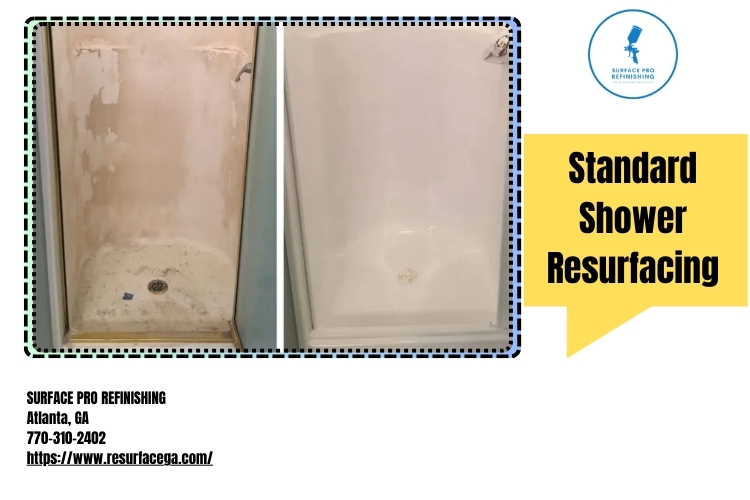Introduction
Bathtub reglazing is an art—one that can transform the ordinary into the extraordinary. For Atlanta residents, a city known for its historic architecture and modern flair, maintaining the aesthetic integrity of their bathrooms is crucial. Whether your bathtub is chipped, stained, or simply outdated, reglazing offers a cost-effective solution that breathes new life into this essential fixture. In this comprehensive guide, we’ll explore the ins and outs of bathtub resurfacing, reglazing, and refinishing. We’ll break down each step of the process while addressing common questions and concerns along the way.
What is Bathtub Reglazing?
Bathtub reglazing refers to a specialized process where a worn or damaged tub surface is restored to its original condition using a new finish. This technique can be applied to various types of bathtubs, including porcelain, fiberglass, and acrylic fixtures.
Why Choose Bathtub Reglazing?
- Cost-Effective: Compared to replacing an entire bathtub, reglazing is much cheaper. Time-Saving: The process typically takes only a few hours. Environmentally Friendly: Reglazing extends the life of your current tub, reducing waste. Aesthetic Appeal: You can choose from various colors and finishes.
The Benefits of Bathtub Resurfacing
Enhanced Durability
Resurfacing significantly increases the life expectancy of your bathtub by applying high-quality materials resistant to wear and tear.
Customizable Options
You can tailor your tub's appearance with different colors and textures to suit your personal style or match existing bathroom decor.
Minimal Disruption
Unlike full replacements that might take weeks and involve extensive construction work, resurfacing is quick and often requires less cleanup afterward.
The Differences Between Reglazing and Refinishing
While both terms are commonly used interchangeably, there are subtle distinctions:
- Reglazing typically refers to applying a new glaze over an existing surface. Refinishing may involve more extensive repairs prior to applying a new finish.
Understanding these differences helps you make an informed decision about which service best suits your needs.

The Art of Bathtub Reglazing: A Step-by-Step Process for Atlanta Residents
Now that we've covered the basics let’s dive into the detailed steps involved in bathtub reglazing specifically tailored for Atlanta residents.
Step 1: Assessing Your Bathtub's Condition
Before starting any work, it's essential to evaluate your tub's condition. Look for chips, cracks, or rust that may require additional attention during the reglazing process.
Step 2: Gathering Necessary Supplies
You'll need specific tools and materials:
- Epoxy filler for cracks Sandpaper (various grits) A mask and goggles for safety Paint sprayer or rollers (for applying glaze)
Step 3: Preparing Your Workspace
Ensure proper ventilation in your bathroom. Remove all items from around your tub area, including bath mats and toiletries. Cover surrounding surfaces with plastic sheeting to avoid overspray damage.
Step 4: Cleaning and Repairing Damage
Thoroughly clean your tub using a strong cleaner to remove soap scum and grime. After cleaning:
Fill any chips or cracks with epoxy filler. Sand down areas needing repair until smooth.Step 5: Masking Off Areas Not Being Refinished
Use painter's tape to cover areas you don’t want coated in glaze—like faucets or tiles—to achieve clean lines.
Step 6: Applying Primer (If Necessary)
A primer coat may be required depending on your bathtub material. This ensures better adhesion of the glaze later on.
Step 7: Mixing Glaze Components (If DIY)
Follow manufacturer instructions carefully when mixing two-part glazing compounds. It’s vital for achieving lasting results!
Step 8: Application Techniques for Glaze
You can use either a paint sprayer or https://www.resurfacega.com/ Bathtub refinishing rollers:
- If using a sprayer, maintain consistent distance from the surface. For rollers, work in small sections while avoiding drips.
Step 9: Allowing Proper Drying Time
Once applied, allow sufficient time for drying as per product recommendations—typically around 24 hours before using it again.
Common Mistakes During Bathtub Reglazing
Skipping Surface Preparation Neglecting Safety Gear Overlooking Drying Times Using Poor Quality ProductsFAQs About Bathtub Reglazing
1. How long does bathtub reglazing last?
Typically between 5 to 10 years if properly maintained!
2. Can I use my tub immediately after reglazing?
No! It's crucial to wait at least 24 hours post-reglaze before using it again.
3. Is DIY reglazing advisable?
While possible with careful attention to detail, hiring professionals often yields better results due to their expertise!
4. What types of tubs can be reglazed?
Most tubs made from porcelain enamel steel or fiberglass can be successfully reglazed!
5. How much does bathtub reglazing cost?
Costs vary widely but generally range from $300-$600 based on size and condition!
6. Will reglazing eliminate all imperfections?
While it significantly improves appearance and durability, deeper structural issues may still require repair!
Conclusion
In conclusion, understanding "The Art of Bathtub Reglazing" empowers Atlanta residents to make informed choices about their home improvement projects. With proper preparation and execution—or by opting for professional help—you can enhance not just the look but also the functionality of one of your home's most essential features—the bathtub! With expert knowledge at hand now available through this guide alongside practical tips shared throughout our discussion; you're well-equipped as you embark upon rejuvenating that beloved bathing oasis!
Whether you're considering DIY options or seeking professional services in Atlanta's vibrant market space; remember—the journey toward restoring beauty begins here!
Contact Us
SURFACE PRO REFINISHING
Location: Atlanta, GA
Phone: 770-310-2402
Website: https://www.resurfacega.com/